Jobs, Education, Peace Protest March & Rally
Labour Party Conference, Brighton. Sunday 27 Sept 2009
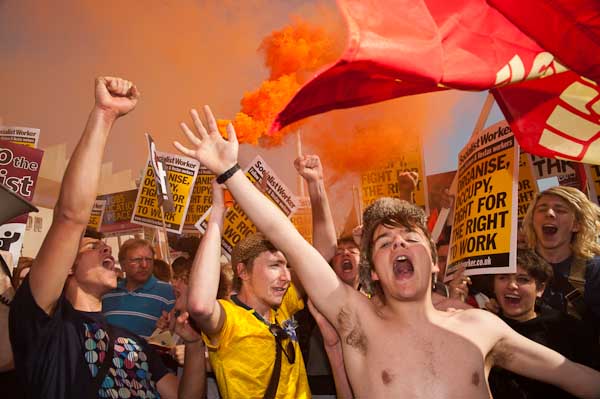
Three orange marine distress flares were set off opposite the Labour
Party Conference
more pictures
Around two thousand marchers, including a large group who had come on a
specially chartered train from London as well as many from further away,
made their views clear to the Labour Party in a march and rally outside
the centre where the Party was in conference at Brighton on Sunday.
Called by trade unions and pressure groups - the UCU, NUJ, PCS,
NUT, CWU and RMT, Right to Work, Stop the War and Unite
Against Fascism - they demanded a change in direction over
proposals to cut public expenditure.
The big news for the march was that the strike at Tower Hamlets College
by members of the University and College Union to save jobs there had
been successful. After almost a month on strike, an agreement to avoid
25 compulsory redundancies there was reached in talks at the arbitration
service ACAS and announced the previous day. The proposed cuts would
have reduced or closed services to some of the most vulnerable and
disadvantaged people in our society. The message from Tower Hamlets was
clear "We Fought & We Won."
Also at the front of the march and in the marchers thoughts were
workers from Vestas Blades, inexplicably abandoned by the
government when the management decided to close this vital green
industry down in the Isle of White and move production to the USA. The
UK needs to take a great leap into wind power over the next few years -
and could become a net exporter of electricity across Europe using newly
developed low-loss DC transmission technology on a new super-grid. This
clean green technology is already proven to work - while the government
seems committed to gamble on the unlikely pipe-dream that the dirtiest
of power-generation technologies - coal-fired power stations - can be
tamed by 100% carbon capture and storage.
Although it was predictable that this march would be peaceful and
without incident, and the organisers were cooperating fully, the police
were taking no chances, with hundreds on duty and walking with the
march. The bill for policing the conference at Brighton runs into
millions and was one item of public expenditure that the marchers would
have readily seen severely trimmed.
There were a few short speeches at the start of the march a few yards
east of the entrance to Brighton's one remaining pier. Among those
speaking was a woman from the campaign waged by cleaners and other low
paid workers in London for a living wage, and another from Youth Fight
For Jobs as well as a final speaker from Brighton and Hove District
Trades Council welcoming us to Brighton. Then the marchers moved off
along the seafront road, chanting noisily and with many union and other
banners.
A short way behind the front of a march, a group mainly of students
marched behind a banner proclaiming 'STUFF THE MARKET - TAX THE RICH'
and they periodically halted to allow a gap to develop in front of them,
working up their chanting to a crescendo before rushing forwards to fill
it, scattering the photographers and videographers in front of them
Approaching the conference centre, the police had routed the marchers
on to the promenade, putting a low hedge and a further row of barriers
between the march and the conference. When this group halted, three
orange flares were let off to the accompaniement of considerable
shouting and waving of fists.
The march continued to the 'Peace Statue' a few hundred yards further
on, and then went down to beach level, walking back along the lower
promenade to an open area not far from the conference centre, although
more or less out of sight, for the final rally.
Speakers were Sally Hunt (UCU), Martin Reed (NUT),
Mark Flowers (former Vestas worker), Pete Murray
(NUJ), Weyman Bennett (UAF), Caroline Lucas MEP, Jeremy
Corbyn MP, Richard McEwan (UCU Tower Hamlets College),
Lindsey German (Stop the War), Tony Kearns (CWU), MIchael
Bradley (Right to Work), John McDonnell MP and Mark
Serotka (PCS).
The speakers all called for changes in government policy that would
create jobs rather than unemployment, and most stressed the importance
of green jobs. The government had poured billions into supporting the
'casino' activities of banks and paying for obscene bonuses, but had
declined to support Vestas. Internationally governments have failed to
take the decisions necessary to separate the essential banking functions
from their risky speculations and to firmly regulate their activities.
It was important that workers fight to keep their jobs, and actions
such as that in Tower Hamlets showed that it was possible to win these
fights.
Several called attention to the rise of the BNP and the need to oppose
this, regretting the decision of the BBC to feature the BNP leader on
'Question Time' and there was a call for a demonstration at the studios
when this was taking place.
Several also referred to the wasteful spending on the Iraq invasion and
the continuing war in Afghanistan, calling for an end to the wars, the
abandonment of the Trident replacement and of ID cards.
Several unions are considering the possibility of supporting trade union
candidates in elections - the RMT has already done so in the Euro
elections - because of the abandonment by New Labour of its working
class base. Those at the rally were urged to attend a meeting afterwards
organised by Bright supporters of No2UE-Yes to democracy to explore the
issues involved.
more pictures
Gordon on the Gravy Train etc
Labour Party Conference, Brighton. Sunday 27 Sept 2009
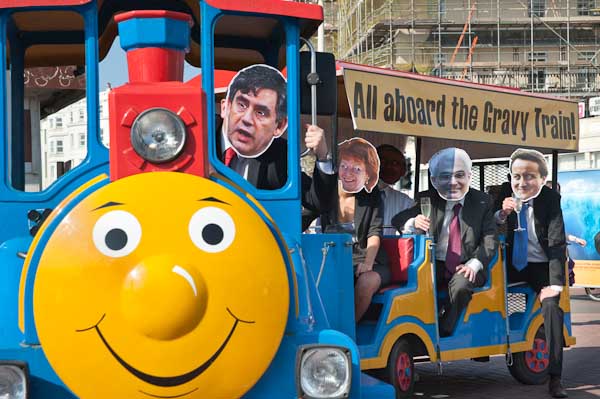
The 'Vote for a Change' campaign's Westminster Gravy Train - and David
Cameron in a blue tie at the back
more pictures
Party conferences are at best rather boring beasts, and given the
current state of the Labour Party and Labour Government, the event
currently under way at Brighton is more desperate than most. Fortunately
there are always a few things happening around the edges to brighten the
day, and Sunday outside the conference hall was certainly a splendid day
with a clear bright blue sky that contrasted with the mood inside
Fortress Brighton, surrounded by armed police and anti-tank obstacles.
On the promenade opposite the conference centre itself was a reminder
of a blot on our and the US government's conscience, the continued
detentions in Guantanamo Bay. The orange clad figures stood holding
letters spelling out the message 'BRING SHAKER HOME'.
Shaker Aamer is one of two former British residents still at
Guantanamo. A 42 year old Saudi national, he has a British family who
live in Battersea; the UK government made half-hearted requests for his
return in 2007, but have failed to follow these up and he is still under
detention. Ahmed Belbacha, an Algerian asylum seeker who lived in
Bournemouth, has been free to leave Guantanamo for two and a half years,
but has chosen to stay there rather than go back to Algeria, where his
life would be at risk; our government has refused to allow him to return
here.
Other protests on the sea front included a call to boycott Israeli
goods and against Control Orders with their use of secret evidence and
Kafkaesque violation of human rights.
Christian Aid's cyclists rode along the seafront with posters
declaring that climate change could push 250 million sub-Saharan
Africans into poverty by 2020 and asking Gordon to "Lead the way" at
Copenhagen in December.
Delegates entering the conference pass a number of people handing out
magazines and leaflets, some on serious and worthy issues and others
more on the eccentric fringe. Given the current housing problems
particularly for many families on lower incomes - which have provided a
major area for the BNP to exploit with racist myths - a return to major
investment in council housing to make some inroads into the massive
waiting lists would seem an excellent idea, and one that would provide a
much-needed economic stimulus. But however much we may approve of
Abraham Lincoln's sentiments on sustainable smallholdings, the idea that
'Domicile Allotments' are a simple solution to climate change is frankly
lunatic.
Rather more serious, but also considerably more amusing is the 'Westminster
Gravy Train' offering free transport to conference delegates by
the Vote for a Change campaign. Following on from the MPs allowance
scandal, this calls for a break with the "voting system that has left
parliament unaccountable and unrepresentative" and calls for a
referendum on electoral reform.
The 'Gravy Train' - a Thomas the Tank Engine tribute - was crewed by
masked figures including Gordon Brown, David Cameron, Hazel Blears,
Alistair Darling and Jack Straw as it made its way along the
seafront road past the conference centre and stopped for photographs in
front of Brighton pier.
more pictures
ABoD Lord Carson Memorial March
Temple Place, London. Sat 26 Sept 2009
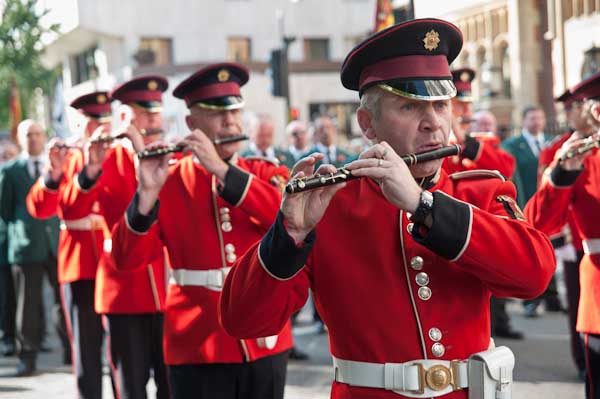
Flute bands play a large part in Orange marches. UVF Regimental Band
more pictures
Each year the City of London Campsie Branch of the Apprentice
Boys of Derry holds a march in memory of Lord Carson and to lay
wreaths at the Cenotaph in memory of the 36th Ulster Division,
formed after a meeting between Lord Kitchener and Sir
Edward Carson from men who already had some military training
(with 30,000 German rifles brought illegally into the country) in the Ulster
Volunteer Force. By the time they were demobilised in 1919, the
division had suffered 32,000 casualties and gained nine Victoria crosses
and many other awards for gallantry. Recognised as one of the most
effective fighting units of the war, it was badly let down by the lack
of organisation and ineffective tactics of the British Army.
I was brought up a Protestant, though most of my relatives thought my
parents excessively liberal; we were Congregationalists while they
worshipped at a Baptist church where the pastor was a friend of the Rev
Paisley. At least one of my ancestors was said to have been imprisoned -
like John Bunyan - in Bedford Goal for his stubborn adherence to the
Protestant faith. My first girlfriend was Catholic and I would not have
dared take her to see my relatives -but was saved the decision when her
uncle, a Catholic bishop, discovered she was going out with a Protestant
and immediately took her back to Malta. Since those days, even in
Ulster, things have changed (though perhaps not in Malta.)
The presence of the London Somme Association and the Harbour
Somme Association from Belfast, along with other reminders of the
First World War brought back memories of my own father, who after
running a machine shop full of women making munitions when he was
underage for service, volunteered and served in the Royal Flying Corps
(later the Royal Airforce.)
The march in London was a ceremonial event and very much a family event
too, with many coming from Belfast, Glasgow, Airdrie, Liverpool, Bootle,
Corby and elsewhere to take part in the event, in which wreaths were
laid at the Cenotaph.
Unlike last year, everyone was friendly to me as I took pictures, and
several mentioned having seen last year's pictures on this web site.
Unfortunately other committments meant I had to leave the march, which
had started late, before it reached the Cenotaph.
Lord Carson was born in Dublin and became Solicitor-General
for Ireland and then for England around the start of the 20th century.
An Irish patriot, he was opposed to Home Rule for Ireland and in 1911 he
became the leader of the Ulster Unionists. The following year, his was
the first signature on the Ulster Covenant in which men
pledged to use "all means which may be found necessary" to
defeat home rule for Ireland (women signed a shorter version without
this promise.) Also in 1912, he was one of the founders of the Ulster
Volunteers, a unionist militia which the following year became
the Ulster Volunteer Force, and in 1914 received 30,000 rifles
and ammunition, bought in Germany and brought to Ireland where the UVF
took over Larne to prevent the authorities stopping the gun-running.
Carson remained the unionist leader until 1921, influencing Ulster to
opt out from Home Rule. He declined to stand as Prime Minister of the
newly formed Northern Ireland Parliament as he felt he had few
connections in the north, and he resigned as party leader, retuning to
work as a judge in London. He was then made a life peer.
Although Carson had became an Orangeman at 19, he was always critical of
the culture of Orangeism. When the Northern Ireland parliament was set
up in 1921 he warned Unionists not to alienate the Catholics with the
words "from the outset let them see that the Catholic minority have
nothing to fear from a Protestant majority." History would have
unrolled very differently if those in Ulster had followed this wise
advice.
more pictures
Camp Ashraf Hunger Strike - Day 60
US Embassy, Grosvenor Square, London. Fri 25 Sept 2009
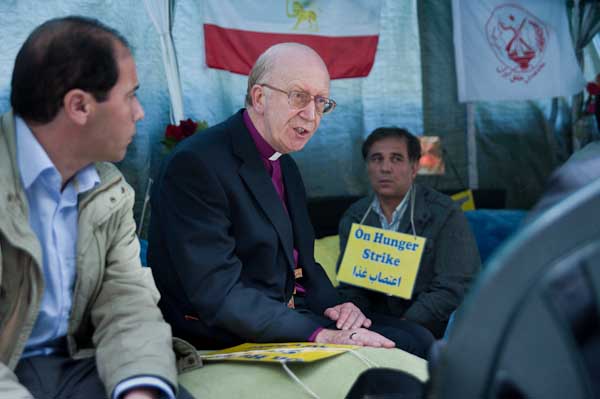
The Bishop of Oxford talks to hunger strikers
more pictures
Camp Ashraf or Ashraf City is an Iranian refugee camp in Iraq
established in 1986 as a home for members of the People's Mujahedin of
Iran (PMOI), one of several sites given to this major Iranian opposition
group by Sadam Hussein.
After the US invasion, US forces took control of the site and a few
months later they seized all the weapons held by the PMOI. Those living
in the camp were designated as protected people under the Geneva
Conventions, protecting them against being deported, expelled or
repatriated.
On 1 Jan 2009, the US handed control of the camp to the Iraqi
government. The US retained a military presence there and gave promises
to the camp residents that they would be treated humanely according to
Iraqi law and that none would be deported to any country were they had a
"well-founded fear of persecution."
Following demands from the Iranian regime that the Ashraf residents be
extradited to Iran, Iraqi forces entered the camp on July 28-30 this
year. According to reports the US forces at the camp simply stood and
watched as a variety of weapons - including batons, axes, water cannon
and live ammunition - were used to attack the 3500 unarmed Iranian
refugees, who include a thousand women. Journalists were kept out of the
camp, but according to Amnesty, film footage shows Iraqi military
Humvees being used repeatedly to run down residents.
Eleven residents are reported to have been killed in these attacks,
with around 500 wounded. 36 men were taken away and are still held
without trial or charges being laid. They are reported to have been
tortured, and most are now on hunger strike and in a critical state.
A camp was set up outside the US Embassy in Grosvenor Square London by
families of the victims of Camp Ashraf. Twelve Iranians are on hunger
strike there in sympathy with those deatined in Iraq, and today they
were on the 60th day of this protest. Several have already been taken to
hospital because of critical organ failures, but are continuing their
protest.
Daily, hunger strikers from the camp at the US Embassy go to 10 Downing
Street to urge our government to take action, but so far there has been
no response from the British or US governments to their demands. The
hunger strikers ask for the release of the 36 detainees and a withdrawal
of Iraqi police from Camp Ashraf and for access to the camp for lawyers,
journalists, doctors and relatives. They want temporary protection by US
forces until an international force can take over, and the immediate
stationing of an international monitoring team at the camp by the United
Nations Assistance Mission for Iraq.
The atrocities during the attack on Camp Ashraf and the continuing
detention of the 36 (despite two legal decisions in Iraqi courts that
they be released) have received little attention in the international
press, while in the UK news media have chosen to ignore the protest
outside the US embassy.
Organisations including the Law Society, Amnesty International and the
Church of England have lent their support to the campaign. While I was
visiting today, the Bishop of Oxford was visiting the camp in Grosvenor
Square and he will report to the Archbishop of Canterbury, who earlier
on 20 September issued a strong statement: "The continuing situtaion in
Camp Ashraf together with the fact that 36 people taken from the camp in
July have not been released, constitutes a humanitarinan and human
rights issue of real magnitude and urgency." He also supported the
demands for UN monitoring, calling for a response as a matter of
urgency.
This is another issue that has received little coverage in the media.
The interest in the UK protest taken by the Archbishop of Canterbury has
however meant some interest from the religious media, and it has
featured on the early morning BBC radio religious 'Sunday' program.
more pictures
LGBT Solidarity at Serbian Embassy
Belgrave Square, London. Friday 25 Sept 2009
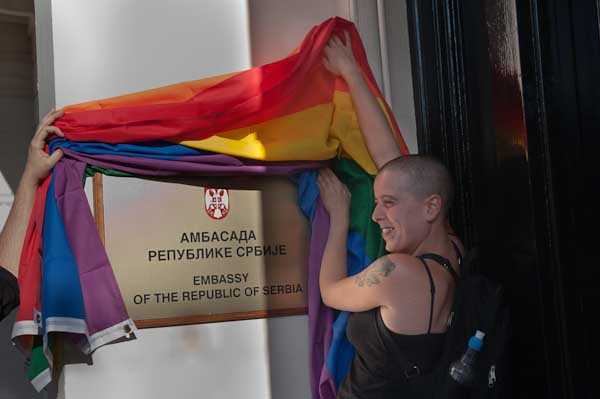
Rainbow flag at the Serbian Embassy
more pictures
A peaceful protest took place at the Serbian Embassy in London on
Friday 25 Sept to show international solidarity with the LGBTQ community
in Belgrade following the cancellation of Beograd Pride, due to take
place last Sunday, 20th September. As is quite often the case I was the
only journalist to cover the event, and posted a short report with
pictures on Indymedia and Demotix.
Around 40 people, including supporters of Outrage!, the NUS
LGBT group and Queers Without Borders protested on the embassy
steps, handing in a letter to the ambassador expressing their deep
concern and urging the Serbian authorities to show determination in
pursuing individuals and organizations who are associated with criminal
acts against LGBT people or venues, to protect those who have given
public support to Pride and LGBT people, to work with LGBT organisations
to create a more positive attitude in particular to allow Pride 2010 to
proceed normally in Belgrade.
The letter reminded them of the importance of protecting the human
rights of its population, including the estimated 5% LGBT people, and of
the importance of protecting the democratic rights of citizens in view
of the country's aspiration to EU membership.
Belgrade's first gay parade in 2001 had to be abandoned after violent
protests on the streets of Belgrade.
It took eight years until Serbia's LGBT community felt it was possible
to hold a second parade. But mounting threats from nationalist
ultra-right groups and football fan clubs - including offensive graffiti
and posters threatening violence on almost every street in the city
centre - led the authorities to decide that they were unable to protect
the marchers - despite earlier promises to do so being repeated by
President Boris Tadic the previous day.
The day before the march was due to take place, the organisers met with
Prime Minister Mirko Cvetkovic who suggested that they move the march
away from central Belgrade and when they declined to do so, the march
was cancelled. The Serbian government were clearly embarrased by the
coverage this got around the world and have promised that there will be
a Pride march in Belgrade in 2010 - but then they promised it would
happen this year.
more pictures
Autumn Equinox: Druids at Primrose Hill
Primrose Hill, London. Tuesday 22 Sept 2009
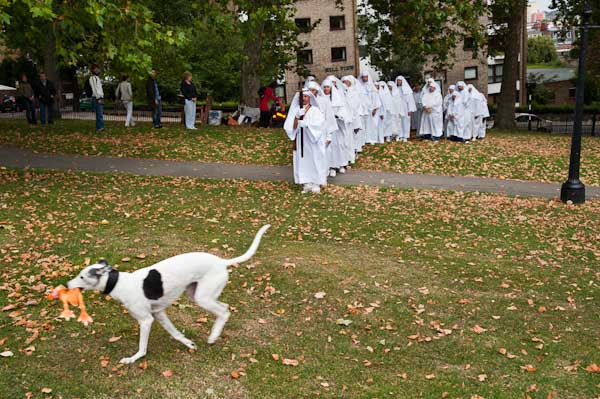
A dog with a stolen rubber chicken in its jaws runs across in front of
the druid procession
more pictures
We don't know a great deal about the druids who were already ancient
when the Romans came. Roman historians described them as wise but
bloodthirsty, given to human sacrifice that stained the altars of
Angelsey with blood, and although the evidence of conquerors is always
untrustworthy what little archaeological evidence there is supports the
cruelty (but not the wisdom.) Fortunately today the members of The Druid
Order are peace loving. free-thinking and rather photogenic in their
white robes, and their main aim is to develop themselves through being
rather than through intellectual learning.
The Druid Order celebrated the Autumn Equinox (Alban Elued) with a
ceremony on top of Primrose Hill in London at 1pm in their traditional
robes.
After processing up the hill to form a circle, a long horn was sounded
to the four corners of the world and then the sword was held aloft to
each in and pulled loose with the call "Is it Peace?" and on receiving
the reply "Peace", pushed back.
The lady, representing the Earth Goddess Ceridwen then requested
permission to enter the circle with her two attendants, and it was
granted. They brought a horn containing cider and a basket of fruit and
flowers, the harvest of the earth to the chief druid. The cider was
tasted, then carried around the circle with libations being poured onto
the earth. He also received the basket of fruit and flowers and this too
was emptied out as he walked around in the circle.
The names of companions of the ancient order no longer with us were
read out, including that of the artist William Blake and other
well-known historical figures. We all observed a minute or two of
silence and their was a fairly long address. Near to the close of the
event, the druids joined hands around the circle and renewed their druid
vows. In a final act of the ceremony, four druids came to the centre of
the circle and raised the hands in turn to proclaim peace.
Everyone present was thanked for coming and an invitation issued to
those who want to find out more about the order to attend their regular
public meetings.
The druids then left the circle in order through a gate made by two of
their number and processed away down the hill, again forming a circle
briefly before beginning to disrobe.
I walked back to the top of the hill to sit and admire the view - and
to eat a delicious apple from the fruit they had scattered there.
The Druid Order was formed, along with a mythic history linking it back
to earlier times, around a hundred years ago by George Watson MacGregor
Reid. The 'history' links it back to a call by John Toland on Primrose
Hill at the Autumn Equinox of 1716 for a meeting of Druids at the Apple
Tree Tavern in Covent Garden a year and a day later. According to the
Fifth
Mount Haemus lecture by Dr Adam Stout in 2005, their first
recorded appearance appears to have been at the Summer Solstice at
Stonehenge in 1912, although Macgregor Reid may have been there in 1909.
A photograph from 1912 shows him striding through the stones in Indian
dress leasing his "Universalists." The following year he was back,
describing himself as a High Priest and "the direct successor of the
Chief Druids who have been" and dressed in a very similar manner to that
still adopted by The Druid Order.
MacGregor Reid was, it appears, in many respects a remarkable
character, involved in virtually every aspect of the counter culture of
the late 19th and early 20th century. He was a trade union agitator,
into oriental mysticism, labour party activism and of course druidism
and the establishment of a universal church in Clapham.
Although he was not the earliest or the only latter-day druid to
celebrate the Summer Solstice at Stonehenge, it was his repeated annual
celebrations at or close to the site, often despite its owners or, after
it became national property, the Ministry of Works, that established its
current preeminence as a symbol of alternative culture.
At the top of the hill is a large circular memorial plaque to Iolo
Morganwg (1747-1826), an important figure in the re-invention of a
Druidic tradition and marking the site of the first meeting of the
Gorsedd of the Bards of the Isle of Britain on Midsummer's day 1792. He
invented descriptions of Druid ceremonies and added these, together with
some of his poems, into the translations he made of medieval Welsh
manuscripts. The memorial was unveiled earlier this year on Midsummer
Day 2009, and the Welsh Gorsedd continues as a part of the national
Eisteddfod. Morganwg also introduced the 'Awen' symbol with its three
'rays' still used by the Druid Order.
more pictures
Urban Green Fair
Brockwell Park, Brixton, London. Sunday 20 Sept 2009
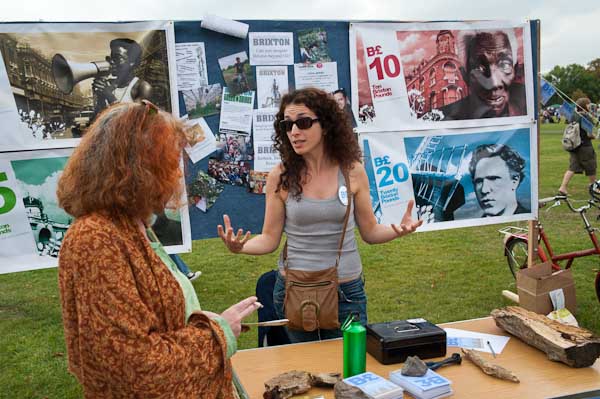
Explaining the advantages of the Brixton Pound
more pictures
There was much of interest at the Urban Green Fair, but little that I
really felt I wanted to photograph, but it was a pleasant afternoon. One
of the oddities of this event is that it's very hard to get an alcoholic
drink there, though I did manage to track down a cup of cider. The food
too didn't look very appetizing, and I was glad I'd brought a sandwich.
There was organic produce, bees, an apple press and bicycles, as well as
rather a large zone offering massage of head, feet and elsewhere and
other nutty fringe offerings of no interest to me.
The Brixton Pound - accepted by many of the small shops in Brixton -
seemed a good way to encourage local business, including some green
businesses, but not of much use if you don't live in Brixton (and I
don't.)
Apart from the bikes, there seemed to be little about green
technologies, though there were some greener computers on offer (low
power consumption seemed to be the main feature) and one example of a
wind turbine.
The highlight for me was the performance by Mark Thomas, and I took a
front row seat to take pictures. I've met and photographed Mark at a
number of demonstrations, and of course heard him on radio, but this was
the first extended performance - almost an hour - by him I've actually
been at in person. When I get time I'll certainly read his book "Belching
Out the Devil: Global Adventures with Coca-Cola" which is both a
serious piece of investigative reporting and hilarious.
Afterwards I went to visit the Community Garden in the park, which was
also interesting. I'd tried to see it on my previous
visit, but it had been closed.
more pictures
Bermondsey Street Festival - Zandra Rhodes
Birthday
Bermondsey St, London. Saturday 19 Sept 2009
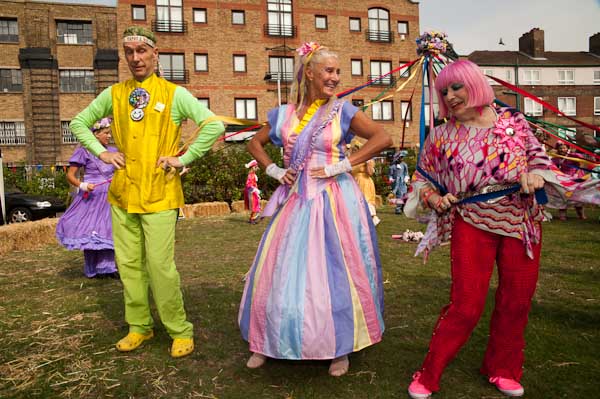 Andrew Logan, Donna Maria and Zandra Rhodes
Andrew Logan, Donna Maria and Zandra Rhodes
more pictures
Old and new Bermondsey came together for a lively street festival on
Saturday 19th Sept on Bermondsey Street, one of the oldest streets in
the area.
Donna Maria's Maypole, dancers based in South London,
entertained in the main arena in Tanner Street park, with her colorful
recreation of an ancient English tradition.
At the end of their first session, Zandra Rhodes (b 1940)
came to open the festival, and was presented with a birthday cake, pink
and in the shape of the letter Z, which she cut. Both she and artist Andrew
Logan joined in the maypole dancing with Donna Maria.
One of the key developments of the new Bermondsey is the Fashion
and Textile Museum founded by fashion designer Rhodes and opened
in 2003. She is the patron of the Bermondsey Street festival, now in its
third year, and as well as opening it also had a stall on the street.
The events on Bermondsey Street culminated in an hour long fashion show
which featured dresses by leading designers now located in the area,
including dresses by Zandra Rhodes with jewelry by Andrew Logan.
Bermondsey used to be one of the more notorious areas of London, though
massive redevelopment in the late nineteenth and first sixty years of
the twentieth century replaced its slums by council flats and other
social housing. Now it is filling up with expensive flats, designer
dress shops and trendy cafes and is one of the more lively up and coming
areas of the capital.
When I published an Industrial Archaeology walk around West Bermondsey
in 1992 the idea of guided walks around the area was novel. Today,
guided walks led by Blue Guides were on offer in the festival as well
cycle tours led by Southwark cyclists and tours of the church.
The redevelopment of Bermondsey Square, completed in 2008 has changed
that area completely, but does still include a large open space which
was also in use for the festival, along with the church of St Mary
Magdalen, parts of which are medieval.
more pictures
Save Vestas Action Day
DECC, Whitehall Place, London, Thursday 17 Sept 2009
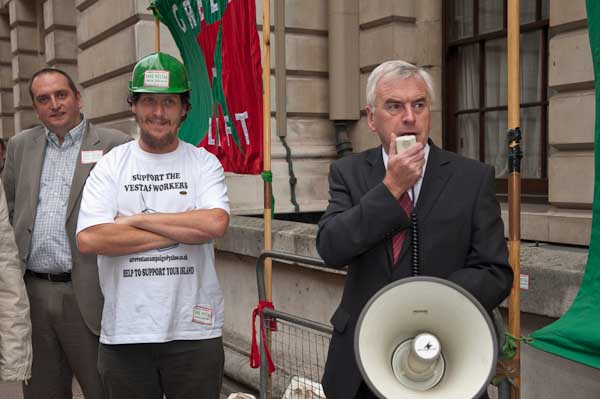
Darren Johnson, Mark Flowers and John McDonnell at the rally
more pictures
Events around the country marked the Vestas 'Day of Action for Jobs
and the Planet' on Thursday 17 Sept. The TUC conference in
Liverpool passed a motion of support and in London a demonstration was
held outside the Department of Energy and Climate Change in Whitehall
Place.
Speakers at the rally, which was organised by the Campaign Against
Climate Change, included John McDonnell, MP, Darren
Johnson, Green Party spokesman on trade and industry and chair of
the London Assembly, trade union organisers and Mark Flowers,
one of the sacked Vestas workers.
The rally demanded that Vestas reinstate the sacked workers and give
better redundancy packages to all of their staff, and that the
government must take over the Vestas factory and create green jobs
across the country.
Several speakers commented on the bitter disappointment felt at the TUC
conference at Secretary of State for Energy and Climate Change Ed
Miliband's total failure to express any practical support for Vestas
when he spoke to Congress yesterday. Although talking about the need for
green jobs he continues to ignore the most obvious and direct way he
could support this.
Earlier in the day PCS activists from the London branch had organised a
lunchtime rally outside the DECC - and some also came to the later
demonstration. In the evening there was a public meeting organised by
the NUJ with speakers from the NUJ, NUT and UCU as well as a Vestas
worker.
Outside London, there were also events taking place as a part of the
Vestas day of action in Birmingham, Manchester, Newcastle, Newport, IOW,
Rotherham, Southampton, Warrington, Chatham and Cardiff.
more pictures
Miliband Faces Climate Critics
DECC, Whitehall Place, London, Monday 14 Sept 2009
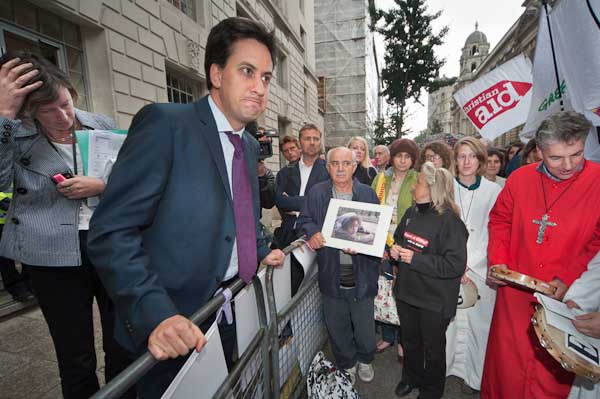
Minister Ed Milband listens to a tough question on climate change and
his government's response
more pictures
Minister Ed Miliband came out to meet Climate Chaos
Coalition (CCC) protesters who had gathered outside his
Department of Energy and Climate Change offices this evening to urge him
to put a stop to the use of "climate-wrecking dirty coal power."
He responded to some critical questioning about the government dragging
its feet over renewable energy with claims that he was working hard on a
similar agenda to the protesters and was very aware of the challenges we
face over climate change.
Although many were unconvinced by some of his answers (and may suspect
that government policy in this area is more driven by the Treasury and
the Department for Transport than the DECC) everyone present was
impressed by his willingness to come and spend almost fifteen minutes in
the rain talking with the protesters and making a genuine attempt to
answer the questions and criticisms.
He ended by thanking everyone for raising public awareness of the
issues by taking action in the way we have, and also stressed the
importance of groups such as the CCC keeping up the pressure in the run
up to the UN climate summit in Copenhagen in December, where decisions
taken will be crucial for the future of the planet.
Leaders of some of the organisations in the CCC had earlier met with
the minister to impress on him the vital importance of abandoning coal
for power generation unless and until 100% efficient carbon capture and
storage can be proven to work. The public consultation on a new
coal-fired power station at Kingsnorth closed last Wednesday, Ed
Miliband has now to make his decision.
Other speakers at the vigil included Ashok Sinha, Director of the Stop
Climate Chaos Coalition, while Christian Aid provided a fine campaigning
choir in clerical garb which performed a number of well known tunes with
new climate-friendly lyrics which others present joined in - and for
once everyone was really singing from the same song sheet. The coalition
involves virtually all of the major environmentally concerned groups in
the UK, including Friends of the Earth, Greenpeace and the Campaign
Against Climate Change, as well as faith groups, aid agencies and many
others - a total of over 100 organisations with a total membership of
more than 11 million.
more pictures
Al Quds Day March
Marble Arch to Waterloo Place, London .Sunday 13 Sept 2009
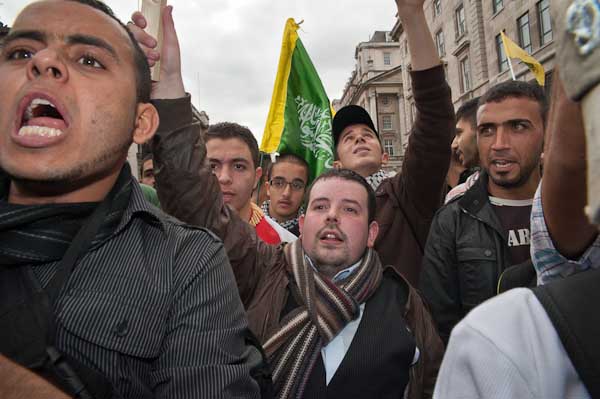
Marchers approaching Piccadilly Circus
more pictures
he annual Al Quds Day (Jerusalem Day) march in London has
aroused increasing controversy over the years, and was met by several
small counter-demonstrations from individuals along the route and
several small groups of protesters at Piccadilly Circus. After a series
of violent clashes at anti-Islamic demonstrations involving right-wing
groups, most recently outside the Harrow mosque on Friday, police were
prepared for trouble when these groups, including the English
Defence League and March For England, called on their
supporters to gather and protest against this march.
Other protesters included Iranian democrats, royalists and socialists,
particularly incensed at the recent rigged election results in Iran and
the demonstrations that followed, with Neda Agha-Soltan being killed and
others who died in jail.
Although Al Quds Day was initiated by Ayatollah Khomeini when he became
Supreme Leader of Iran in 1989 as a day on the last Friday of Ramadan
(the London march is on the following Sunday) to oppose the Israeli
occupation and control of Jerusalem, and several of more prominent
groups leading the demonstration in the UK have links with Iran, the
event has support from a wide range of organisations including the
Muslim Council of Britain and the Respect Party.
Several thousand marchers left Marble Arch, led by Muslim clerics and
two Neturei Karta anti-zionist Jewish leaders. Before the march there
was an announcement that although as usual women would march in the
centre, led and followed by the men, it was also made clear that those
who wanted to march as families were welcome to do so, and many,
particularly the younger marchers, took advantage of this.
Along the route people chanted the familiar slogans, which were printed
for convenience on the small Palestinian flags many of the marchers
carried, calling for an end to the occupation of Palestine and Israeli
violence. Some carried pictures of the Israeli atrocities of the war in
Gaza and there were calls for the end of the building of illegal
settlements on occupied territory. One of the main messages was for
people to support the boycott of Israeli goods, which appears to be
having a real effect.
At Piccadilly Circus, the police had erected a large pen for the
counter-demonstrators, which would have held at least twenty times the
small number there, and it was ringed by several times as many police as
protesters. Surprisingly photographers told me police simply watched and
refused to take action when they were assaulted and pushed out from the
pen by the hooligans there. Some of these also refused to be penned, and
police followed several groups who left around the area. I saw four
young men being stopped near Hyde Park corner and one was questioned and
searched while he hid under his jacket before they all ran off away from
the demonstration.
As the demonstration passed the waiting groups in Piccadilly Circus
there was considerable shouting from both sides, but police kept the
march to the opposite carriageway and together with march stewards, held
back marchers eager to go and confront the opposition. Another row of
police - in places a double row - kept the protesters behind their
barrier and held photographers a short distance back. As well as
shouting insults at the Muslims, they were also making threats, gestures
and shouting at the photographers, and I was glad not to be too close
although the police bodies made taking pictures difficult.
The police had also insisted that the march not continue to Trafalgar
Square for the rally as in previous years. In view of the small number
of counter-demonstrators, this was perhaps an unnecessary precaution,
but the crowded venue in Waterloo Place did give the event a greater
intimacy than it would otherwise have had. Among the speakers before I
had to leave were Roland Rance, Taji Mustafa of Hizb ut-Tahrir Britain,
Yvonne Ridley of the Respect Party and Neturei Karta Rabbi Ahron Cohen.
more pictures
Photographers Flash-Mob at Canary Wharf
Canary Wharf, London. Saturday 12 Sept 2009
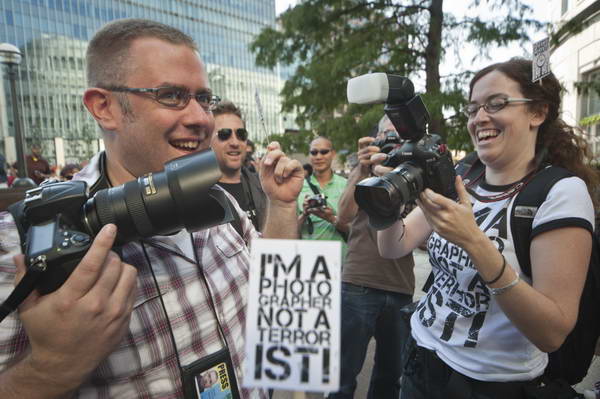
Photographers at the Canary Wharf Flash mob
more pictures
I'm a Photographer not a Terrorist! was inspired by a poster campaign
launched by the Metropolitan Police that suggested that anyone with a
camera was a terrorist as well as the increasing legislation against
photography and the harassment by police and others that photographers
face when taking pictures on the street.
Hardly a week passes by without another story of a photographer being
questioned and sometimes arrested when photographing shops, bus
stations, footpaths, parks or other public places. In the face of clear
advice from the Home Office (recently strengthened) that photography is
legal in public places and that anti-terror laws should only be invoked
where there is a clear and reasonable threat of terrorism, police,
PCSOs, council officials and others continue to take action against
photographers, often citing laws against terrorism.
The Canary Wharf estate is one of an increasing number of 'public'
spaces in cities that is privately owned - including many shopping
centres and some office areas. Photographers who try to take pictures
here may be asked to leave and risk being abused and restrained by
security guards, although tourists taking pictures are usually
tolerated. At various times at Canary Wharf, security guards have
stopped me or attempted to stop me when photographing a war memorial,
demonstrations and a violent assault by security staff on a member of
the public as well as when taking architectural and urban landscape
images.
At 3pm on Saturday 12 Sept, around a hundred photographers descended on
Canary Wharf in London for a flash-mob protest around the clocks in the
square below Canary Wharf Tower. They produced cameras on the stroke of
three and began photographing everything in site - mainly each other.
Security men stood around watching the protest from a distance but took
no action.
more pictures
DLR and River Thames
Limehouse & Isle of Dogs. Saturday 12 Sept 2009
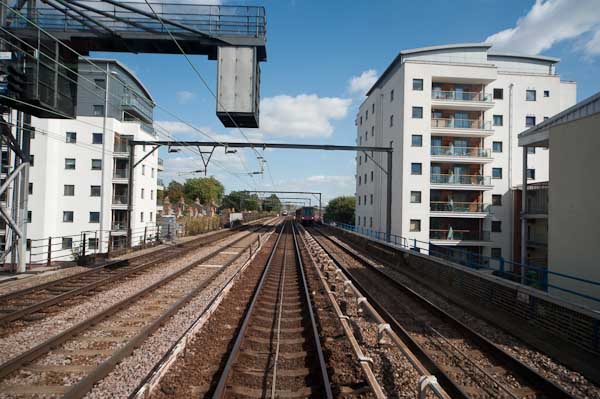
On the Docklands Light Railway you can pretend to drive
more pictures
London's underground system was in more or less total collapse, with
planned engineering works closing down over half of the lines and
signaling and other problems messing up most of the rest. The few
remaining services were hot and crowded. I needed to be sure to get to
Canary Wharf for 3pm, but neither the DLR or Jubilee was running there
from Westminster where I was.
I'd hoped to drop in at the rally at Aldgate to support the strike at
the colleges in Tower Hamlets, but there was no Circle Line and District
Line services were stopping at Tower Hill. Traffic was bad, and the
chances of getting there on a bus, and then getting the bus on to Canary
Wharf after a short stop seemed pretty low, so I gave up the attempt.
Buses to Canary Wharf are always slow and timings unreliable so I took
the DLR to Westferry. Probably I could have gone on by rail replacement
bus, but it wasn't in sight and I just had time to walk, taking the more
pleasant route along the Thames path, and stopping for a minute or two
to take some pictures. I made it with around five minutes to spare.
more pictures
Cuban 5 - Political Prisoners in US
Angel, Islington, London. Saturday 12 Sept 2009
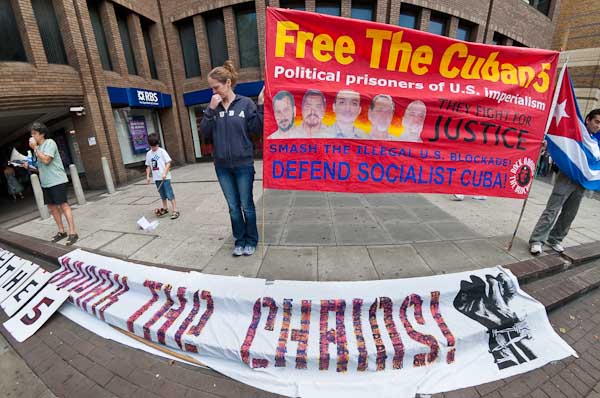
Break the Chains - Free The Cuban 5 - rally at the Angel
more pictures
Last Saturday was the 11th anniversary of the jailing of the
Cuban 5, political prisoners in the US, and it was marked by
events around the world urging their release. In London, Rock
around the Blockade held a rally outside Angel Tube station in
Islington across lunchtime, speaking and handing out leaflets in the
busy street. The rally was supported by other groups including Fight
Racism! Fight Imperialism!
The Cuban 5 are five Cuban men who infiltrated CIA-backed expatriate
Cuban terrorist groups based in Miami, Florida. They discovered that an
extremist group 'Brothers to the Rescue' was practising its
plans to bomb Cuba by dropping pipe bombs from airplanes, and the Cuban
government passed on the evidence of this illegal activity to the US
administration.
The US response was to arrest the five Cubans who had discovered the
plot and to set up a trial in Miami where in 1998 three were sentenced
to life imprisonment and the other two to 15 and 19 years in prison.
A US court in 2005 decided in 2005 that their trial had been unfair and
ordered a retrial in a new location. The Attorney General had this
decision overturned and the convictions were upheld in 2006 and 2008.
Despite an unprecedented number of petitions from human rights
organisations, jurists and others from around the world, the US Supreme
Court refused to examine the case this June; Obama had urged them not to
hear it. A retrial is to start shortly for three of the men, but under
the same judge who found them guilty at the original unfair trial.
The whole prosecution is a part of the political war by the US against
the socialist revolution in Cuba which started in 1959. Cuba is seen as
a threat to their control and business interests in the whole of Central
and South America and determined to isolate and destroy it. The infamous
'Monroe Doctrine' originated by President James Monroe in 1823
now means that Latin American countries are free to choose any
government they like so long as it isn't too left-wing.
Apart from an abortive attempt at invasion - the Bay of Pigs, proposed
by Nixon, planned by Eisenhower, approved by Kennedy and turned into a
fiasco by the CIA, the main weapon used against Cuba for the past 50
years has been a US commercial, economic and financial blockade,
repeatedly condemned by the United Nations, most recently by 185 votes
to 3 with 2 abstentions.
more pictures
Memorial Procession for Victims of the Arms
Trade
Victoria Dock, Custom House, London. Friday 11 September 2009
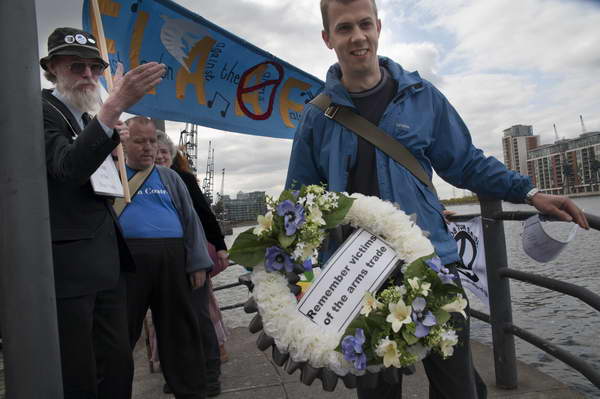
A wreath for victims of the arms trade was launched onto the dock
opposite the DSEi arms fair
more pictures
In 2005, local residents formed 'East London Against the Arms Fair'
(ELAAF) to oppose the government-sponsored Defence Systems &
Equipment International (DSEi) held every two years at the ExCeL centre
in Canning Town, East London. Organised by Clarion Events and the UK
Trade & Investment's Defence & Security Organisation (UKTI) - a
government department, this is one of the world's largest arms fairs,
bringing together over a thousand arms companies from around their world
and clients who include many from countries known for flagrant human
rights abuses, as well as those actively involved in wars and civil
wars.
The deals made at ExCeL will lead to many people in countries across
the world suffering from repression, being injured and being killed. The
money spent on arms also distorts the economies of many countries, with
money that should be spent on development and meeting basic needs going
to waste.
EELAF has held a number of peaceful musical protests against the arms
fair at the Excel site before the fair as well as making representations
to all those involved in the fair, including the owners of ExCeL, the
state-owned Abu Dhabi Exhibition Company. They held a number of protests
this week, beginning with a candle-lit vigil on the eve of the fair on
Monday, and a day of action at ExCeL and outside the UKTI offices on
Tuesday. As the fair was coming to an end on Friday afternoon, a small
group of around ELAAF supporters led a Memorial Procession from close to
the entrance of the DSEi arms fair around Victoria Dock to the south
side. There they held a short ceremony of remembrance for the many
killed by arms sold at previous fairs and those who would be killed by
the arms sold at this week's event. A wreath was launched onto the water
of the dock opposite the warships moored outside the arms fair and a
minute of silence was followed by the singing of peace songs and the
holding of hands.
Unlike at protests held at the arms fair two years ago, the police were
polite and helpful, the officer in command coming to ask what the
protesters intended to do and promising the assistance of the police in
maintaining their right to make a peaceful protest. Although there was
an obvious police presence around the DSEi, police kept well away from
the demonstration. ELAAF is pledged to continue to hold regular meetings
and protests until the arms fairs stop being held in East London.
Climate Rush: Aylesbury Green Fayre
Kingsbury, Aylesbury, Bucks. Wed 9 September 2009
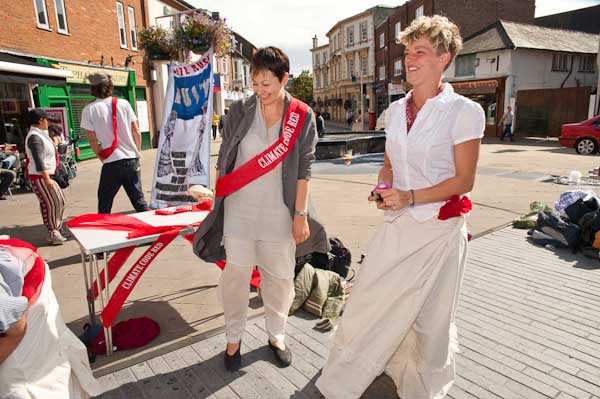
Caroline Lucas and Tamsin Omond at Kingsbury before the Green Fayre
started
more pictures
Aylesbury was the most northerly point of the Climate Rush tour of
South West England. They were camping at Haddenham a few miles away, and
came into Aylesbury to hold a Green Fayre in Kingsbury, a pedestrian
area in the centre of Aylesbury with a few pubs and cafés as well as
shops around its edges, and a water feature with a number of small
fountains.
Wednesday was one of the best afternoons of the summer, warm and sunny,
and although it wasn't crowded there were enough people around to make
the event worthwhile. As well as the Climate Rushers themselves, there
were two other attractions, with a chance to meet and listen to both
Green Euro-MP Caroline Lucas and celebrity cookery writer and
TV performer Hugh Fearnley-Whittingstall.
At the start of the event, Tamsin Omond and some of the other
Climate Rushers in the long white suffragette dresses and red sashes
carried one of their banners (EQUITY: Emission
Quotas Must Be Per Capita; The Rich Have No More Right To Pollute Than
The Poor) around the nearby busy market area and nearby streets,
Tamsin announcing in a surprisingly loud voice the chance to meet both
the TV Cook and one of their Euro MPs.
Whether because of this or not, throughout the afternoon quite a few
people stopped to talk to Hugh and tell him how much they enjoyed his
programme. Others just edged towards him, stopping a few yards away
phone in hand to take a picture.
There were a few short speeches and quite a few people came over to
take leaflets and stopped to talk to the Rushers about climate change
and what they could do. A few children came to do some drawing, and some
people wrote notes about environmental issues to be sent to the local
MP.
Aylesbury Museum rose to the occasion, bringing their own stall on
which people could make paper bead necklaces, and more to my taste,
bringing apples and the rare Aylesbury plums from trees in their gardens
to give away. Other gardeners brought produce too, and we enjoyed eating
them, including some raw petit pois, with raw Jerusalem artichoke a
special treat.
It really was a very pleasant afternoon, and as things began to quieten
down and I sat there drinking a pint of beer from the neighbouring pub,
enjoying the company and the fine weather, it was easy to begin to think
that all was well with the world. But of course it isn't, but this was a
reminder that the planet we have really is worth saving. And if we all
take action soon, possibly we still can.
more pictures
CAAT: Close UKTI DSO
Victoria St, London. Tuesday 8 September 2009
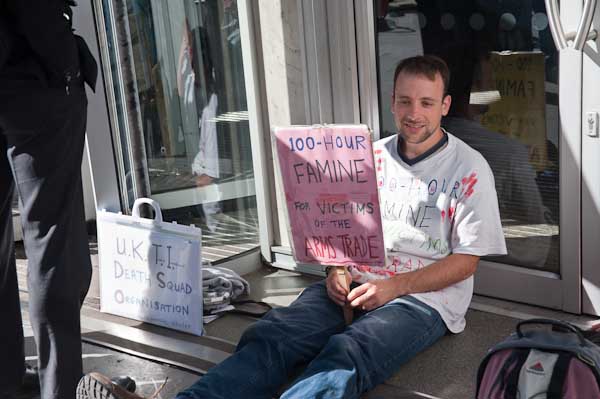
Dan Viesnik on his 100 hour Famine for Victims of the Arms Trade at
UKTI with the CAAT protest
more pictures
CAAT (Campaign Against the Arms Trade) had demonstrated outside the
DSEi arms fair at the ExCeL centre earlier while I had been following
the autonomous Disarm DSEi march around the city, and in the afternoon
came back to Victoria St to demonstrate outside the government offices
of UK Trade and Investment (UKTI), whose Defence and Security
Organisation provides financial, political and logistical support for
the arms fair, channeling our taxes to help private companies to profit
from making the arms used to kill people.
To highlight the death, injury and deprivation caused worldwide by the
arms trade, Dan Viesnik was making a 100-hour famine at various
government offices and other locations around the city, and was outside
the UKTI while the CAAT demonstration was taking place.
more pictures
Disarm DSEi
City of London. Tuesday 8 September 2009
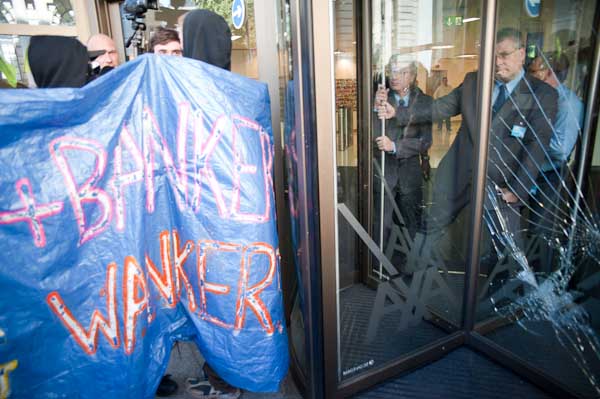
At the door of AXA Investments
more pictures
Disarm DSEi was a protest against the world's largest arms fair which
opened that day at the ExCeL centre in East London, and it targeted the
city offices of companies heavily involved in the arms trade. The
protest stopped outside a number of their offices for short speeches
about the company involvement and made a great deal of noise.
Disarm DSEi provided an excellently produced and well-researched
'infopack', 4 A4 pages with a map listing over 25 companies - including
arms traders, law firms, institutional investors and banks with heavy
involvement in the arms trade, from which I've used a few quotes below.
They stressed that this protest had "no organisers" and that it belonged
to all those taking part who would together decide on its course of
action.
The event started outside the RBS in Aldgate ("the world's leading
creditor to the arms industry ... over £44.6 billion in the last ten
years including loans to producers of cluster bombs and depleted
uranium munitions." It also financed the purchase of Clarion who
run the DSEi arms fair. From there we went to Barclays "the largest
investor in the global arms trade with £7.3 billion in shares."
The next stop was at Legal & General at the top of Coleman St,
where people stuck notices on the doors of the building. They own "£795
million worth of shares in the UK arms trade" and around three
times as much in the international arms industry.
Opposite each other in Gresham St were Schroders and Lloyds TSB, again
with huge shares in the UK arms industry. Lloyds are "principal
banker to BAE Systems and QinetiQ " and "have given £33.3
billion in loans over the last ten years, including loans to produces
of of cluster bombs and depleted uranium munitions."
At the BT offices they made a rush of the door and managed to break
through it and go into the atrium for a short while to continue the
protest inside before leaving. Many of the staff and visitors in the
building gathered at balconies surrounding the atrium to watch what was
going on. Although there was a little damage as they pushed through the
door and jumped over the security gates (I slowly followed them) there
seemed to be little if any deliberate vandalism and no attempt to attack
any of the people inside. "BT hold £59 million worth of shares in
the international arms trade."
Later at AXA Investments ("£2,259 million worth of shares in the UK
arms trade and &6,207 million investment in the international arms
industry") they pushed hard against the door which was held by
two security men, and smashed some of the glass with a reinforced
banner, but seemed to give up when the door finally appeared about to
burst open.
Outside the Stock Exchange ("where all the dirty dealing gets done")
in Paternoster Square the march appeared to come to an end and the
banners were put away. L left to cover another demonstration against the
arms fair elsewhere.
Police made no attempt to stop the march and kept a fairly low profile
throughout, although at times I saw a FIT team taking pictures - and of
course in the city everyone is on hundreds if not thousands of CCTV
cameras. The 'infopack' included the advice "MASK UP!! Don't submit
to police surveillance" and many on the protest did so. It's
something that photographers often find adds interest to pictures too.
But even when wearing masks a few protesters still tried to stop
photographers taking their pictures. Crazy if you want other people to
know about your protest and what you are protesting about.
more pictures
Climate Rush: Celebration of
Community Resistance
Sipson, London. 5 Sept 2009
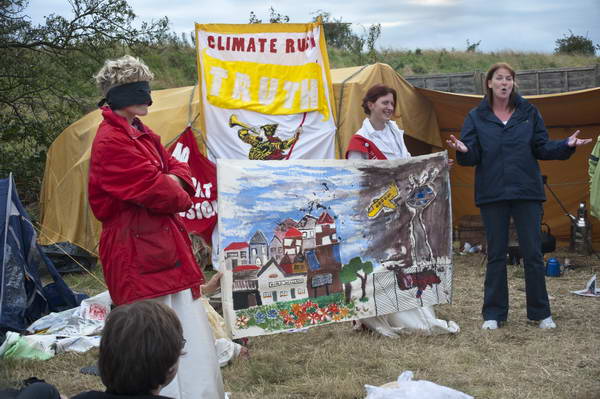
Tamsin plays the villain BAA while Geraldine talks
about the NoTRAG campaign
more pictures
Activists from around the country came to give short presentations on
their campaigns, including those against Radley Lakes, Fos-y-Fran,
Rossport, The IMF/World Bank, Vestas, a message from Cathy McCormack in
Easterhouse, and finally Geraldine talked about the campaign against the
third runway at Heathrow.
more pictures
Climate Rush on the Run
Hayes & Sipson, London. 5 Sept 2009
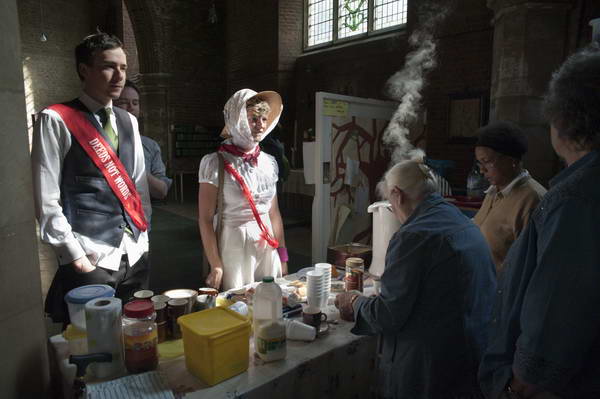 Climate
Rushers get tea and biscuits in St Anselm's Church, Hayes, before the
London Churches Environmental Network walk.
Climate
Rushers get tea and biscuits in St Anselm's Church, Hayes, before the
London Churches Environmental Network walk.
more pictures
The Climate Rush was organised to mark the 100th
anniversary of the 'Suffragete Rush' of 13 Oct, 1908, when more
than 40 women were arrested in as they attempted to enter The Houses of
Parliament.
To mark this centenary, on the evening of Monday 13 Oct, 2008, women
concerned with the lack of political action to tackle climate change
organised and led a rally in Parliament Square, with the key suffragette
slogan "Deeds Not Words" calling for "men and women alike" to
stand together and support three key demands:
* No airport expansion.
* No new coal-fired power stations.
* The creation of policy in line with the most recent climate
science and research.
My pictures of the rally
and the rush on 13 October.
Since then the Climate Rushers have gone on to organise and take part
in various other events, including Climate
Rush at RBS, the Pedal
Power Bike Rush, a mass bicycle ride around London to Westminster
Bridge and a Palm
Oil Gala in Grosvenor Square, as well as a number of other
protests I haven't been at.
Currently the Climate Rush is "On the Run", on "a rollicking tour of
South West England", staging events, supporting campaigns and
"entertaining the towns, villages and hamlets" on their route. The tour
includes "16 Climate Suffragettes, 3 horses and 2 glorious caravans",
though not all of them were there for the first port of call at Sipson
(and the caravans looked more like carts to me.)
They aim to promote awareness of the great possibilities offered by a
low carbon future and to "inspire a nationwide campaign of civil
disobedience against the climate criminals who are holding us back - a
campaign as stylish, effective and unstoppable as the Suffragettes."
I missed much of the fun on Friday at Sipson, including a kids activity
session and a tea party for local residents, and I'm told there was
great musical evening. The Sipson Airplot is also just a few yards from
a great local pub.
The first event on Saturday was only attended by a very small group of
Climate Rushers who had made the short train journey to Hayes to join a
service and walk by the London Churches Environmental Network.
The rushers had to leave the walk after three-quarters of a mile to rush
back to Sipson, getting in some walking practice for the tour on the two
and quarter mile stroll to the Airplot.
Back on site there was lunch to be eaten and final preparations to be
made for that afternoon's 'Celebration of Community Resistance'
(see above.)
The Climate Rushers tour continues with events at Haddenham and
Aylesbury (8-10 Sept), then Oxford (12-13th), Stroud (18-19th), Bristol
(21st), Taunton (24th), Exeter (26-7th) before ending at Totnes on 30th
Sept. See their web site
for more details.
more pictures
Climate Rush Procession Heathrow
Sipson & Heathrow, London. 4 September 2009
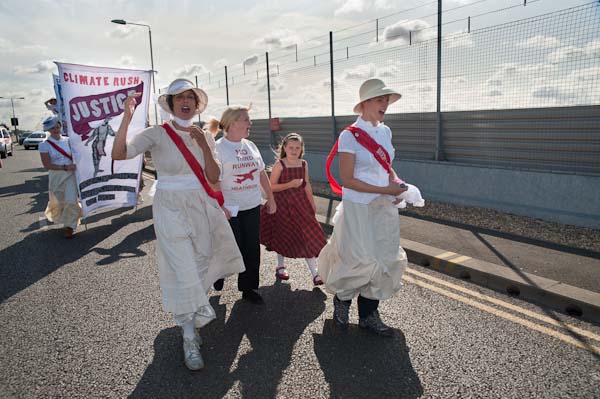
Climate Rushers and local residents lead the 'NO THIRD RUNWAY'
procession at the airport perimeter fence
more pictures
The Climate Rush have started on a one month tour of South West England
and I was very pleased to be able to join them at their first stop at
Sipson this morning. Slightly less pleased that my own trusty steed, a
13th birthday present from my oldest brother a few years ago, punctured
a few hundred yards short of the Airplot site where they had been
camping over night.
Greenpeace bought the Airplot site in the middle of the site for a
third runway at Heathrow and invited everyone to join the plot as a
beneficial owner, alongside the four legal owners, "Oscar winning
actress Emma Thompson, comedian Alistair McGowan and prospective Tory
parliamentary candidate Zac Goldsmith and Greenpeace UK." You can
still sign up for your small
piece of the site, and most if not all of us today had already done so.
The hope is that it will make it harder for the legal notices to be
served so for the development of the site to go ahead.
I first photographed the opposition to the further development of
Heathrow in 2003, when local residents organised a
march against the proposal for a third runway, and have attended
and photographed a number of protests since.
I grew up under the main flight path in use for landing a couple of
miles from touchdown. Although I was a plane spotter at an early age,
all of us living there felt the disruption it caused in our lives, even
back in the 1950s. My teachers often had to stop and wait in
mid-sentence for a plane to go over. We could often smell the fuel, and
see and feel the oily grime although I don't think the term "pollution"
had then really entered normal vocabulary. At a deeper level, I still
sometimes have nightmares about planes going over in flames (as they
sometimes did) and crashes, although since Terminal 4 blocked one of the
existing runways (Heathrow was built with six though only two are now
used) thankfully planes no longer shake my present house as they come in
low on landing or take off.
Although there are claims by the industry that planes are quieter now,
noise is still a problem for us - as it is for perhaps a quarter of
Londoners. Partly this is simply because there are many more planes, but
also that many pilots cut costs by making steep turns on full power
shortly after take-off and fly back over this area. Official noise
measurements still seem to be made to fail to reflect reality although
possibly less blatantly than in the past.
My sister lives under the flight path at least twice as far from the
airport as me, but the noise there is often unbearable. Even very much
further away, at Vauxhall, noise is still a problem, as you can see from
the recent
film by Jason N Parkinson.
Back in the 1950s we knew Heathrow was in the wrong place; it only
gained permission for development by pretending it was needed for
military use (a lie from the start.) Every further development there has
always been obtained by underhand means. When T4 was built, they gained
permission by promising they would never ask for a further terminal. At
the enquiry for T5, they said they would never ask for a third runway.
It was only a matter of months before the application came in. The plans
for Terminal 6 (which of course they would never need) were published in
2005.
Heath Row had some of the best agricultural land in Britain, and the
surrounding area was the site of some of the oldest settlements in the
country long before the Romans came for that very reason. Most of its
prehistoric sites have been lost, some under the airport, others under
other developments or dug up for gravel. My grandfather had a market
garden and an orchard not far away, and Cox's Orange Pippin, the finest
of all dessert apples, was first recognised as a chance seedling and
cultivated by Richard Cox a mile or so down the Bath Road. There are
apple trees around the Airplot site of different varieties, both eating
and cooking apples, and we also ate damsons from a nearby tree.
Sipson to the north of the airport was one of several Middlesex
villages I used to cycle through as a kid, although development has been
a little harder to it than some. Neighbouring Harmondsworth, also to be
destroyed if the third runway goes ahead, has rather more of its
original charm, with a village green with a pub and church and, a few
yards away, one of the finest medieval tithe barns (2 pictures at bottom
of this page.)
The procession left from the Sipson Airplot, led by local residents
from NoTRAG, though most were at
work today - more were expected later in the day and at the 'Celebration
of Community Resistance' at Sipson tomorrow. Suffragettes (including a
'token' male) wearing 'Deeds Not Words ' and 'Climate Rush' red sashes
carried three banners, Justice, Equity and Truth; Equity traveled on a
horse-drawn cart along with a violinist.
The banners read:
JUSTICE: Rich Countries must recognise historic
responsibility for climate change.
EQUITY: Emission quotas must be per capita; the
rich have no more right to pollute than the poor.
TRUTH: Emission caps must be set in line with
the latest climate science.
We went south down Sipson Road to the Bath Road, and across it onto the
Heathrow site, turning to walk along the Northern Perimeter Road outside
the perimeter fence. There we were joined by a police car, which stopped
traffic for us. A few hundred yards along we were unsure of our route,
and Tamsin Omond who was close to the front of the procession, rushed
across to ask the police how we could return to the Bath Road.
Once we were off the airport site the police left us to find our own
way, back up Sipson Way and Sipson Rd to the Airplot site. Altogether we
had walked around two and a quarter miles, and the one of the three
horses pulling the cart hadn't even raised a sweat. It was time for us -
and the horses - to eat some of the apples. A couple of the suffragettes
climbed a tree to pick some more, but they turned out to be cookers. The
kettle had been hanging over the embers of a wood fire and a few more
sticks soon brought it to the boil for tea.
I sat down to mend my puncture. Unfortunately I its a while since I
checked the repair kit in my pannier, and having found two largish holes
found I didn't have a large enough patch to cover the two of them and
the rubber solution had dried up. It was time for me to walk the six
miles home.
more pictures
More on the Climate Rush at Sipson on 2-5 September:
Celebration of Community Resistance
Climate Rush On the Run! Sipson
top of page
All pictures on this section of the site are
Copyright © Peter Marshall 2009; to buy prints or for permission to
reproduce pictures or to comment on this site, or for any other
questions, contact
me.









 Andrew Logan, Donna Maria and Zandra Rhodes
Andrew Logan, Donna Maria and Zandra Rhodes











